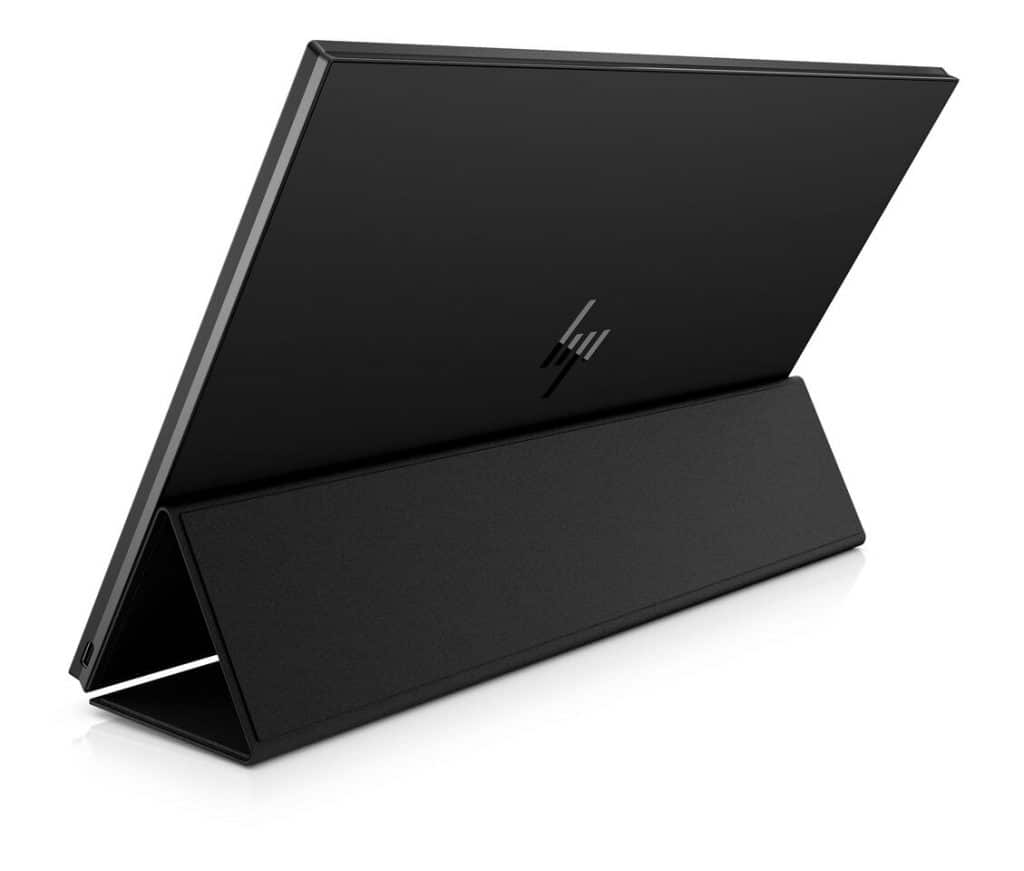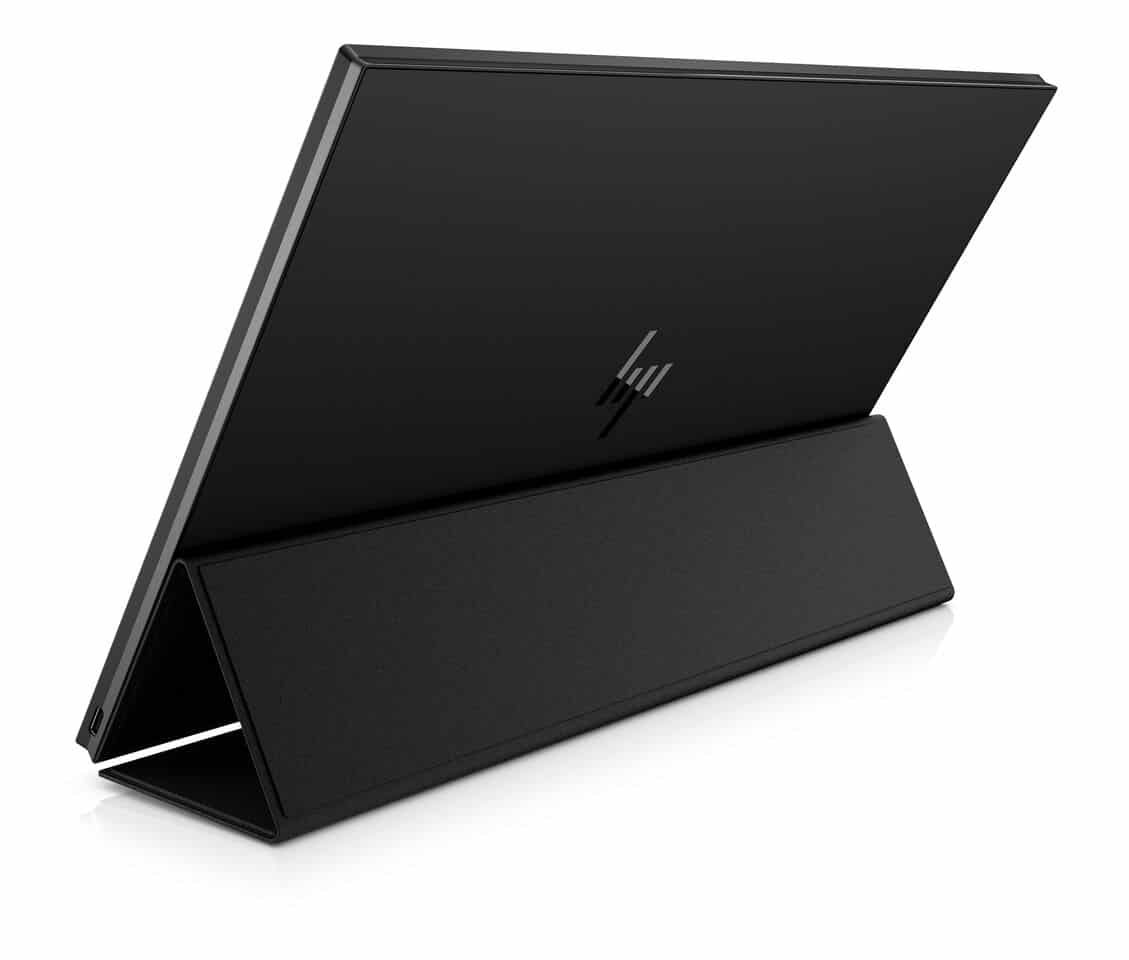Table of Contents
amazon HP EliteDisplay S14 reviews
HP EliteDisplay S14 has some impressive specs for a portable display, though the best of them all lies in just one letter: “C.” This business travel monitor has a full HD native resolution (1,920 x 1,080 pixels), using a 60Hz panel with a 5ms response time. The 700:1 static contrast ratio is nothing to talk about, but it uses an IPS panel, not the lower TFT LCD you might expect. It’s powered — video signals and power — with just one USB Type-C port. If you have a new laptop that supports DisplayPort over USB-C, this is the ideal second monitor companion that will double your desktop space wherever you go and easily look while working.
Small, thin, and neat
When it comes to mobile screens, the quality of the picture is arguably just as important as its physical properties, or maybe just a little less. That is in contrast to a typical desktop monitor, where the image you stare at all day is paramount. It becomes a fixture in your workspace, as permanent and psychologically invisible as wallpaper. Grayscale, low refresh rates, and dim colors aren’t compromises you want or need to make.
However, with a portable monitor, you can live with some visual compromises. Important portable factors such as size and weight, and power requirements should take precedence. If you can’t fit that thing in your luggage, you won’t be able to use it during that big presentation.
The HP EliteDisplay S14 offers most of the physical aspects. The bezels are as thin on three sides of the screen as you’ll see on newer ultra-light laptops, and that’s the kind of mobile-minded device you can pair with this display. Such seemingly subtle and detailed design goes a long way towards creating a product that you want to use. No one wants to put their flimsy laptop next to a giant screen with bulky bezels.
Additional consideration should be given to image balance. Mobile screens are placed side by side with the laptop to which they are connected, and they are usually the same size as that laptop screen. That contrasts with the desktop screen that usually peeks out over a connected laptop on your desk. You want to move the mouse from side to side equally between the laptop screen and the external monitor. While you can easily adjust that through Windows Display Settings, having two monitors that are physically the same size and therefore aligned is certainly helpful.
So the HP EliteDisplay S14 is an ideal companion for a laptop with a 13.3-inch or 14-inch screen. Those with 15.6-inch laptops won’t enjoy the same symmetry. Being quite small makes it more portable – it measures 0.86 x 32.8 x 20.8 cm (HWD) and weighs 1 kg – which is a positive but wouldn’t be ideal if the maximum display is what you need.
The monitor comes with a magnetic cover that doubles as a stand, which is pretty standard pricing for these devices. However, this shell does not enclose the entire device; it just protects the screen. It holds itself in place pretty firmly, so you don’t have to worry about the cover sliding off and scratching the screen, but I wish it didn’t leave the back exposed. Over time, it will get scratched, bumped.
The kickstand only gives you one direction: a horizontal format with approximately 15 degrees of recline. Unfortunately, the HP EliteDisplay S14 doesn’t work in portrait orientation at all. The displayed image will not rotate, smartphone or tablet-style, even if you try to prop the panel on its narrow edge. I’d like to see a little more flexibility here. Being able to choose among three corners or even just between two will go a long way.
The single direction and position are, at least, firm enough for me to feel comfortable leaving it on my desk and walking away without worrying about it falling over.
The only oddity about the magnetic cover is that the magnet is bulky, so there is a wide protrusion on the underside of the display. Aesthetically, it’s not the most appealing. I was worried at first that it would lead to instability, but the rest of the rack compensated admirably. I suppose the strength of the magnet and its size is a worthwhile trade-off.
Controls, Presets and Connectivity
HP EliteDisplay S14 has a power button on the left edge; The important USB Type-C port is right. It comes with a USB Type-C cable that’s about 2.5 meters long, so you’ll have plenty of lengths no matter which side your USB Type-C port is on and what distance you want the display to be.
However, the cable length is a double-edged sword. It can be great if you need the flexibility to move that second monitor around, such as presenting around a desk in a conference room. On the other hand, if you’re trying to fit yourself and your belongings, such as a small Starbucks table, that’s a lot of extra wire. You may want to have another short cable on hand for such times.
Note that there is no separate power cord for the HP EliteDisplay S14. All power is provided by the USB Type-C port on your PC. That is one of the great advantages of USB Type-C. A single-cable solution for power (via USB Type-C’s Power Delivery, or “PD”), audio, and video make for an ideal portable monitor setup, clutter-free and plug-free power plug.
That means, since the laptop, you plug the monitor into is powering this big, bright display, its battery will drain faster than usual, so you should try plugging that laptop into an outlet when you can. But you don’t have to, which is what makes USB-C setups so versatile.
On the other hand, I would like to have a power cable that I can use with the HP EliteDisplay S14, to eliminate the need for power from the connected PC in some cases. Monitors may require up to 15 watts. Furthermore—although no one currently does this on portable monitors, as far as I know—I like the idea of being able to plug the monitor into a wall outlet and use that path to power a connected laptop USB-C connection.
The port and power button placement is ideal, but there are four OSD buttons whose placement is confusing. They are located on the bottom edge of the HP EliteDisplay S14, which is difficult to reach when you put the screen on. Technically, due to the height of the magnet, you can slide a finger down there and to the buttons. But the gap is only 10mm high and 8mm deep so that I can get the tip of my index finger into it. Plus, you can’t see the buttons, so you have to work with them purely by feeling.
However, the OSD’s menu organization is interesting. Pressing any four buttons brings up the same top-level Menu, consisting of four areas (Main Menu, Info, View, and Brightness). Each area is represented by icons aligned directly on the four physical buttons, one after the other. When any button is pressed, you will see the corresponding submenu. Conveniently, the navigation controls for each of those submenus are displayed at the bottom. They change depending on the submenu you’re in, but you can always clearly see which button does what, so it’s pretty easy to use.
The Main Menu gives you access to brightness, contrast, color controls, inputs, picture controls, power settings, and more. You can even tweak the menu buttons, layout, appearance, and more from there. It’s perhaps a bit odd that the brightness, which you can adjust from the Main Menu, has its dedicated menu area, although to be fair, that setting is one you’ll likely use often. By putting it there, you save a single button press. But then you can assign a different setting to that button from the Main mentioned above Menu if there’s something you want to use more often than the brightness setting.
You also get six preset views that you can choose from Low Blue Light, Night, Reading, HP Enhance+, Multimedia, and Photo. If you want to work with different settings to fine-tune the display to your liking, select Custom to use instead of one of the presets.
I’m unclear how the screen defines “Custom,” but it seems to revert to whatever settings you last manually configured. For example, I increased the brightness level to 100 and did the same for the contrast. When I switch to preset then back to Custom, both settings stay at 100.
Performance testing
The HP EliteDisplay S14 isn’t in the same class in terms of performance, most of the monitors we’ve reviewed, but that’s to be expected. It is also not in the same product category as a portable monitor, so we must value the performance results.
We tested brightness, color accuracy, and contrast ratio using the aKlein K10-A colorimeter and SpectraCal CalMAN 5 software. Testing shows that the HP EliteDisplay S14 doesn’t have a particularly wide color gamut. Color accuracy is relatively poor and has a narrower range than other monitors we’ve tested.
It’s also not bright. We measured the HP EliteDisplay S14’s brightness at 171 nits, slightly below its claimed 200cd/m². (One cd/m² = one nit.) However, the black level is 0.167 and counts towards the overall contrast ratio measurement of 1,024:1. That’s not a noticeable contrast ratio, but it does better than the HP-listed 700:1 static contrast ratio.
A test against a higher quality laptop screen (likely to happen in your real-world) tells us that this screen is more black-gray. Even a three-year-old HP Specter x360 has a significantly brighter screen; it’s also a bit duller, not much of a highlight. But since this is, again, a mobile screen, it’s entirely possible. In the end, color and contrast exceeded our (admittedly meager) expectations.
We hesitate to focus too much on gaming performance, as most users won’t use this business travel monitor. A bigger concern is “Will WoW look sweet on this screen?” is “Can I read my spreadsheet?” The answer to the first question is that games look fine — the 60Hz refresh rate is a limiting factor, but the slightly pale colors are more tragic. All things considered, though, it’s a pretty decent experience for a 14-inch mobile screen.
The answer to the second question?
Of course, professional creators like photographers, anyone who shoots and edits videos, journalists, and more. Need a second monitor with at least some degree of color accuracy. In that regard, while the HP EliteDisplay S14 is no substitute for your beautifully color-calibrated desktop monitor when you’re on the road and trying to edit your work in a hotel room, you can do much worse with this monitor.
A smaller screen that does a lot
It’s no surprise that the HP EliteDisplay S14 doesn’t match the quality of a good desktop monitor. It shouldn’t be, and it’s not trying to be. The value of a special portable display starts from the physical factors and ends with a good performance to pass.
In that respect, the HP EliteDisplay S14 scores well. If you have a high-quality laptop, you’ll probably notice a difference in quality when it’s next to the screen, but not much. Given what it is, that’s a compliment to the HP EliteDisplay S14.

